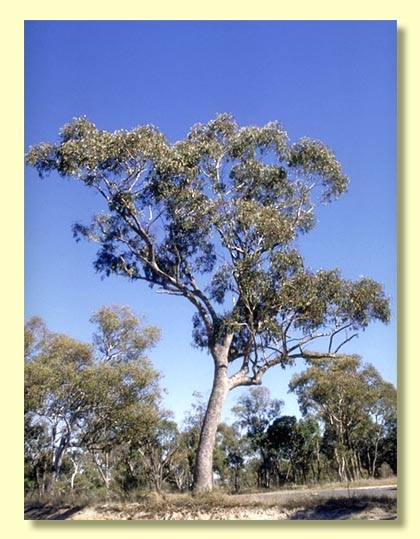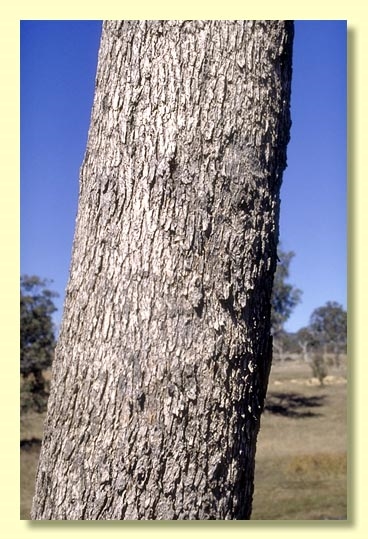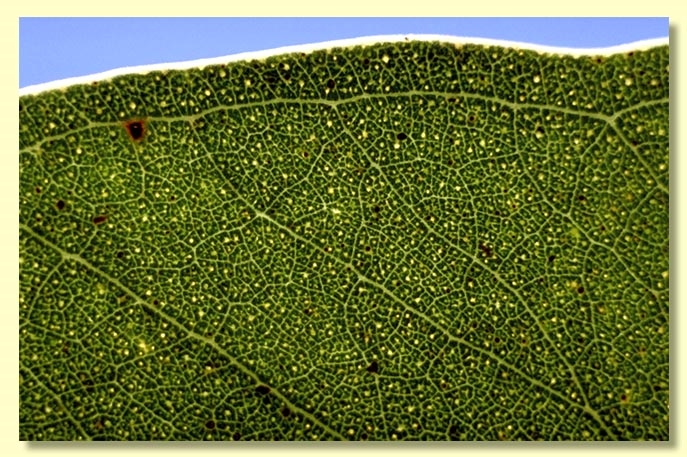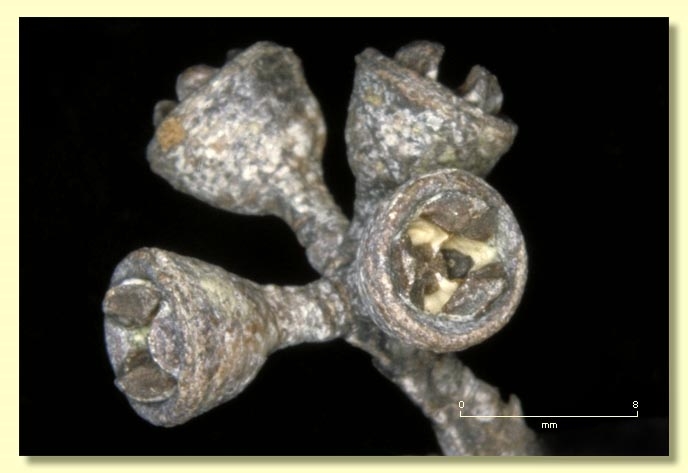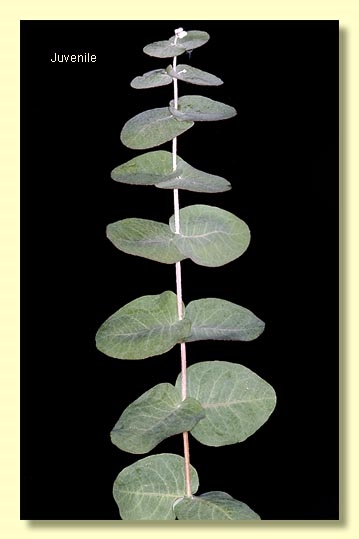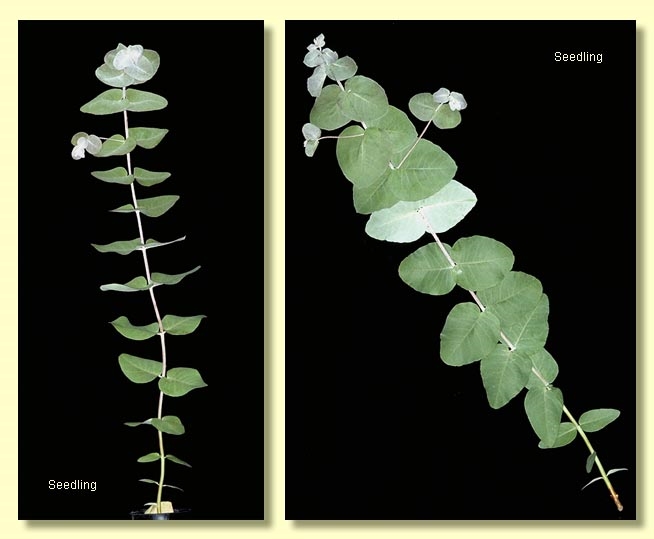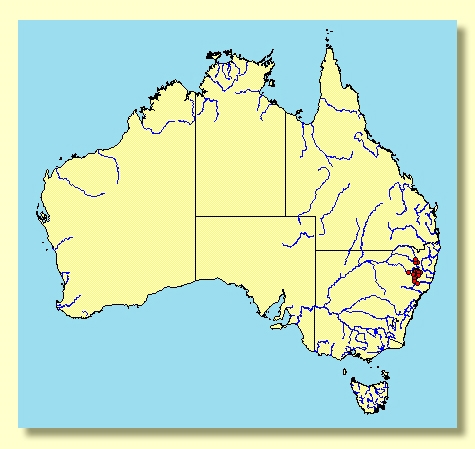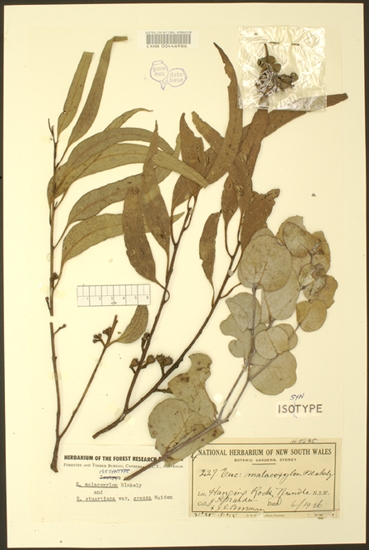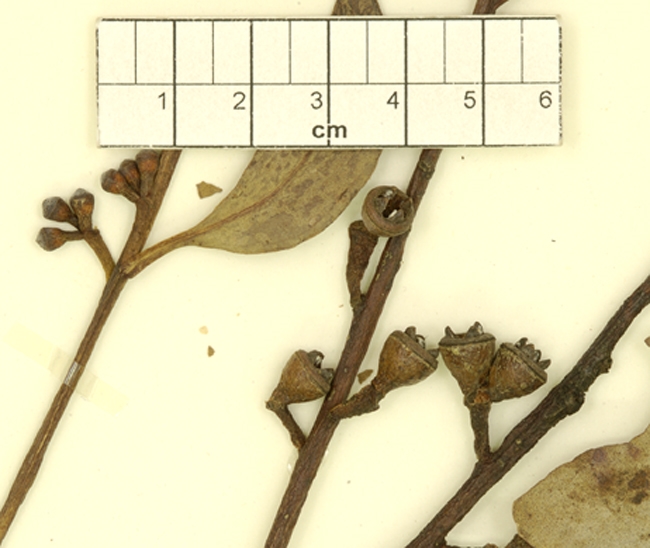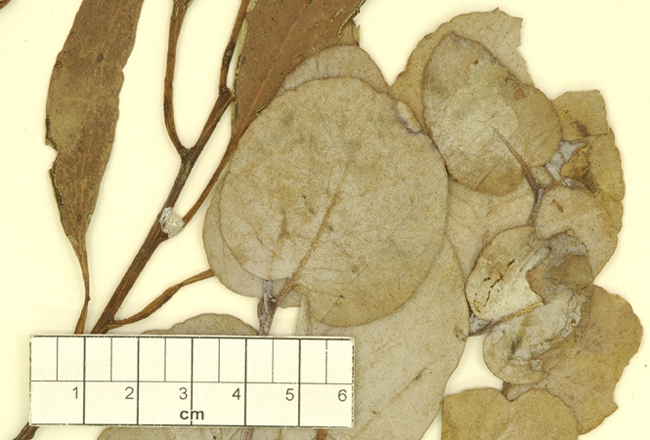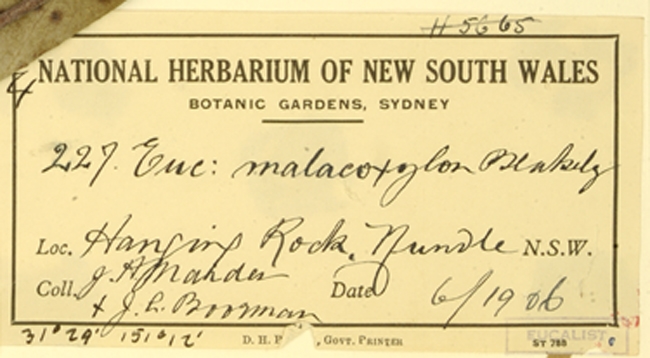Euclid - Online edition
Eucalyptus malacoxylon
Eucalyptus | Symphyomyrtus | Maidenaria | Euryotae | Bridgesiana
Eucalyptus malacoxylon Blakely, Key Eucalypts 145 (1934).
Eucalyptus stuartiana var. grossa Maiden, Crit. Revis. Eucalyptus 3: 69 (1917). T: New South Wales: Hanging Rock, Nundle, J.H. Maiden & J.L. Boorman s.n., June 1906; lectotype: (NSW41833; isolecto A, CANB, K) fide Bean, A.R., Telopea 12(4): 472 (2010).
Bark rough on trunk and branches to ca 5–8 cm diameter, tessellated or box-type, thick, grey.
Juvenile growth (coppice or field seedlings to 50 cm): stem rounded or square in cross-section, glaucous, warty or smooth; juvenile leaves sessile to subsessile for 2 or 3 nodes then shortly petiolate, opposite for at least 18 nodes, cordate, orbicular or ovate, 4–7 cm long, 3–7 cm wide, margin entire or crenulate, base lobed, apex rounded, grey-green to glaucous.
Adult leaves alternate, petiole 2–5 cm long; blade lanceolate to falcate, 9–30 cm long, 2–4 cm wide, base tapering to petiole, concolorous, glossy, green, side-veins greater than 45° to midrib, densely reticulate, intramarginal vein parallel to and remote from margin, oil glands island, intersectional or obscure.
Inflorescence axillary unbranched, peduncles 1–1.7 cm long, buds 7 per umbel, pedicels 0.2–0.6 cm long. Mature buds diamond-shaped with narrow medial encircling flange, ca 0.6 cm long, ca 0.5 cm wide, glaucous, scar present, operculum conical, stamens irregularly flexed, anthers cuboid or cuneate, versatile, dorsifixed, dehiscing by longitudinal slits (non-confluent), style long, stigma tapered, locules 3 or 4, the placentae each with 4 vertical ovule rows. Flowers white.
Fruit pedicellate, rarely sessile (pedicels 0–0.5 cm long), cup-shaped, obconical or hemispherical, 0.4–0.7 cm long, 0.7–1 cm wide, glaucous or non-glaucous, disc raised convex or annular, or disc slightly descending, valves 3 or 4, exserted or near rim level.
Seeds black or brown, 1.5–2.5 mm long, ovoid or flattened-ovoid, often pointed at one end, usually lacunose, dorsal surface shallowly pitted, hilum ventral.
Cultivated seedlings (measured at ca node 10): cotyledons bilobed; stems square in cross-section, glaucous, warty; leaves opposite for many nodes, sessile or shortly petiolate, cordate to orbicular, 4.5–7 cm long, 4–7 cm wide, base amplexicaul to lobed, margin crenulate or entire, apex rounded to broadly pointed, usually glaucous, rarely green.
Flowering time not recorded.
A small to medium-sized tree of very restricted distribution at the southern end of the Northern Tablelands of New South Wales north of Tamworth in the Moonbi, Bendemeer and Nundle areas, usually on granite hills. It is rough-barked and has orbicular to cordate to broadly ovate, glaucous juvenile leaves and glaucous buds and fruits. The operculum slightly overlaps the top of the hypanthium forming a flange. E. malacoxylon belongs to the apple boxes, being closest to E. bridgesiana with differences outlined below.
Eucalyptus malacoxylon belongs in Eucalyptus subgenus Symphyomyrtus section Maidenaria, a large group of species more or less restricted to south-eastern Australia, characterised by bilobed cotyledons, simple axillary inflorescences, buds with two opercula, stamens with versatile anthers and flattened seeds with a ventral hilum. Within this section, E. malacoxylon belongs in series Bridgesianae having rough bark, ovate, crenulate juvenile leaves opposite for many nodes, ovoid buds in sevens, and fruit with exserted valves. The other species in series Bridgesianae are E. angophoroides, a rough-barked tree of better quality sites in south coastal New South Wales and East Gippsland in Victoria, with slightly discolorous adult leaves and green juvenile leaves; E. bridgesiana, a rough-barked tree widespread in eastern New South Wales and Victoria, with concolorous adult leaves and sub-opposite to alternate, glaucous, juvenile leaves and non-glaucous buds and fruit; and E. dunnii, a tall forest tree of subcoastal hills and ranges of northern New South Wales, which is only rough at the base, smooth-barked above and has green juvenile leaves.

